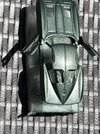stevieb54
Member
- Joined
- Nov 20, 2023
- Messages
- 37
Hey All, I attempted my first time airbrushing yesterday. I was really nervous about doing everything right and said screw it give it a shot. I have these metal cars that were given to me, 63 Stingray. I stripped it down, sanded and spray primered out of a can. Sanded that and tried the airbrush using MCW Highland green gloss enamel. Once I played around with the paint adjustment, it seemed to go ok. I used a reducer (2 parts reducer to 3-4 parts paint).
My end result is the paint seems a satin finish with some orange peel. I have yet to sand the coat and apply either another coat and/or gloss clear. Is this typical of finish when using a reducer, or should I have used a thinner instead? Looking forward to the middle or end of the learning curve. :O)
My end result is the paint seems a satin finish with some orange peel. I have yet to sand the coat and apply either another coat and/or gloss clear. Is this typical of finish when using a reducer, or should I have used a thinner instead? Looking forward to the middle or end of the learning curve. :O)

